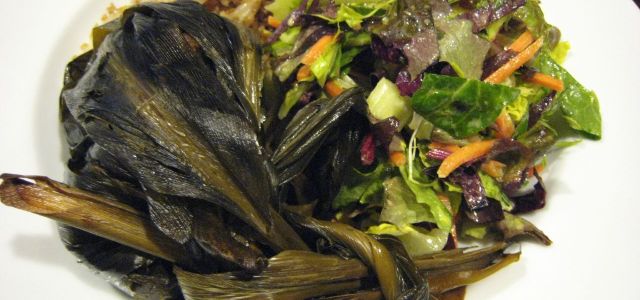
Hawaii is home to a whole host of unique and native dishes. In the same way that there are lots of artistic and cultural specialties that Hawaii is known for, there is also a vast menu. One dish in particular that draws interest is laulau, a specialty plant and meat combination that gives regular dishes a lot to live up to.

The signature element to this dish is the plant, which is called taro. If you’re not familiar with taro, it’s a sweet, almost pear-like root vegetable that often has a purplish look to it when used in dishes. In America, it’s not as commonly used as it is in other countries, due to the fact that it is actually native to Southeast Asia and India. Countries and areas in those regions consider this plant to be an essential part of most menus. You may be familiar with it, though, if you’ve ever had bubble tea. Because of its sweet nature, it’s often used as a flavoring.
Fortunately for you, different cultures around the world have taken this unique plant and integrated it into their special menus. Hawaii’s laulau dish utilizes the leaves off of taro plants, rather than the roots (which are often used in other foods), to create the outside layers that are wrapped around the meat that is used. These leaves are not always a popular part of the plant used as ingredients in food or drink, but for this particular dish, they seem to serve their purpose perfectly. By creating a seal around the meat, they allow it to self-contain moisture, resulting in a pull-apart delicacy.
The process of cooking laulau involves slow-cooking a chosen meat, such as chicken or pork, for several hours, after wrapping the meat in the layers of taro leaves. Often times, a special underground hot stone oven contraption will be used to cook the dish. The result is a tender and savory meat dish that is paired with a soft and juicy crust (the cooked leaves).

Lau Lau with fried rice, bean sprouts and dark green salad SOURCE: Wikimedia Commons
This dish is not only great for its uniqueness, though. Laulau’s inclusion of the taro plant makes it a contender for providing great supposed health benefits. Most believe that taro is rich in many essential vitamins and minerals. In particular, it contains folate (good for pregnancies), fiber (great for digestion), calcium (good for women’s health and bone health), and vitamins that support eye health, like Vitamin C. In addition to these nutrients, taro is thought to be a rich source of antioxidants, which alone provide numerous benefits related to heart health.
If you ever have the chance to make a visit to Hawaii, you may consider trying this uniquely healthy meal. The process alone of seeing how it’s made could be an exciting thing to watch. And you never know, it may turn you on to the taro plant and encourage you to make it a regular incorporation into your diet. In any event, laulau will open your eyes to the delicious food and customs that Hawaii has to offer.